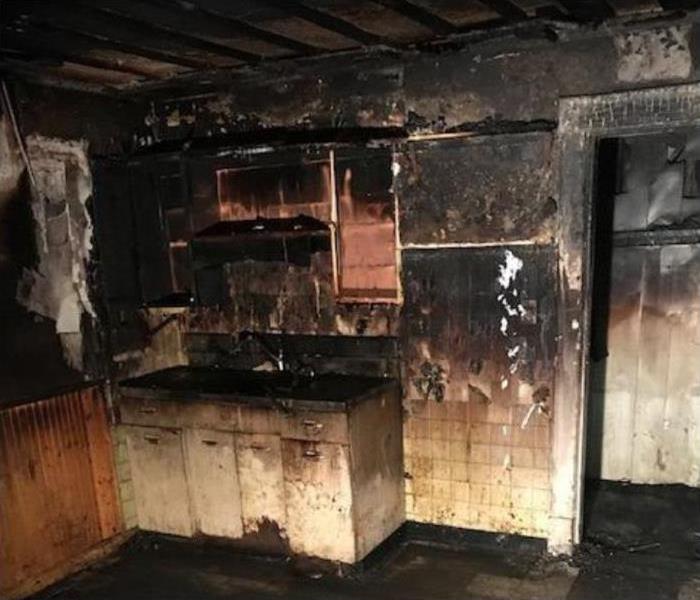What Can I Salvage After a Substantial Fire in My Home?
8/20/2020 (Permalink)
 Not all is lost after a fire. SERVPRO techs have the training and experience to handle all aspects of a fire loss event.
Not all is lost after a fire. SERVPRO techs have the training and experience to handle all aspects of a fire loss event.
SERVPRO Uses Proven Fire Damage Restoration Methods to Increase Your Chances of Salvaging Belongings in Your Easthampton Home
There is plenty to worry about when you have a fire in your Easthampton home. The last thing on your mind should be whether you have the right tools to clean up the debris and charred materials. Instead of taking a chance that your DIY cleaning may compound the damage, SERVPRO has the right tools and techniques to salvage as much as possible. We work with the mindset that it is often better to try to repair and restore rather than replace, which also helps you lessen the cost of the loss.
How Can You Tell Which Belongings Are Salvageable?
When you call on us for fire damage restoration in Easthampton, we have technicians with specialized instruction through the Institute of Inspection Cleaning and Restoration Certification (IICRC). Our team understands that multiple factors are at work that determines your interior belongings and materials after a fire. The way that items are damaged includes their exposure to:
- Flames of the fire
- Heat
- Smoke and soot residue
- Water or chemicals used to extinguish the blaze
In addition to these factors listed above, the length of exposure time also plays a vital role. A fire that gets extinguished quickly lessens damage. However, there is still amplified risk from exposure to fire residues and soot that can cause breakdown or corrosion. Depending on the materials burned, the right methods must also be selected to facilitate the restoration. Some of the more common materials utilized in household furniture include:
- Wood
- Plywood
- Medium-density fiberboard
- Glass
- Acrylic
- Leather
- Textiles
- Plastics, and more
I Have Hardwood Floors, Are They a Total Loss?
We take each Easthampton fire restoration project on a case-by-case basis. Our skilled fire and smoke restoration technicians (FSRT) know how to assess your hardwood flooring to determine the right course of action. Hardwood flooring is generally durable, so our team may have the option of sanding and then refinishing. If the floors are unsalvageable, we will perform controlled demolition to remove all charred materials and replace them with brand-new hardwood flooring.
What Methods are Used for Cleaning Furnishings and Belongings?
Depending on the materials and soiling level, we have a range of dry or wet cleaning methods to try:
- Dry Cleaning –This method works well for clearing away ashy, loose residue, and particles. We use various tools, including dusting cloths, feather dusters, sponges, brushes, and vacuums.
- Wet Cleaning –We use this method for soot and smoke residue that adheres to surfaces. Wet methods work to dissolve, loosen, and suspend using products like mild detergents or low-alkaline surface cleaning agents.
A practical method often used with fire damage restoration is agitation, helping to loosen soiling before removing it. Any dry soot that may not have bonded with a surface can be agitated to make the residue more easily washed or cleaned.
- We have mechanical agitation tools such as rotating brushes that work to remove soot from a heavily soiled surface.
- We use air pressure hoses indoors while we have water pressure equipment for outside use.
- Sandblasting is another form of agitation that allows us to blast away surface soiling and soot to bring about a smooth, clean finish.
How Do You Handle the Wetness from the Fire After Extinguishment?
Any time that water is part of fire-fighting efforts, moisture is often left behind. When this happens, it boosts the chances of odorous elements and mold festering within the fire zone. Without prompt attention, this is a combination that can quickly become problematic and hinder the restoration process. We have our technicians inspect your interior to ensure all water or chemicals from extinguishing the flames get removed before we move to the next phases of drying and deodorizing.
Ventilation is Key
With any fire restoration project, SERVPRO understands that airflow and ventilation help us meet our goals faster. We utilize negative air chambers or containment on an as-needed basis to inhibit soot particles from moving through your home’s ductwork. It also helps keep tracking to a minimum by anyone walking in and out of the loss zone. Additionally, we may:
- Set up air scrubbers with HEPA filters to improve general air quality
- Wipe down surface areas to help eliminate smoke residue traces
Smoke and odor control are also a significant factor for any fire damage project. It is essential not to leave odorous molecules behind that could become a constant reminder of the fire. We utilize a broad spectrum of tools and products to help us stop odors in their tracks, including:
- Thermal foggers
- Hydroxyl generators
SERVPRO of Hampshire County is the team you need on your side when faced with a need for fire damage restoration. Call 24/7 at (413) 324-1300 to have a Green Fleet deployed to your property.






 24/7 Emergency Service
24/7 Emergency Service